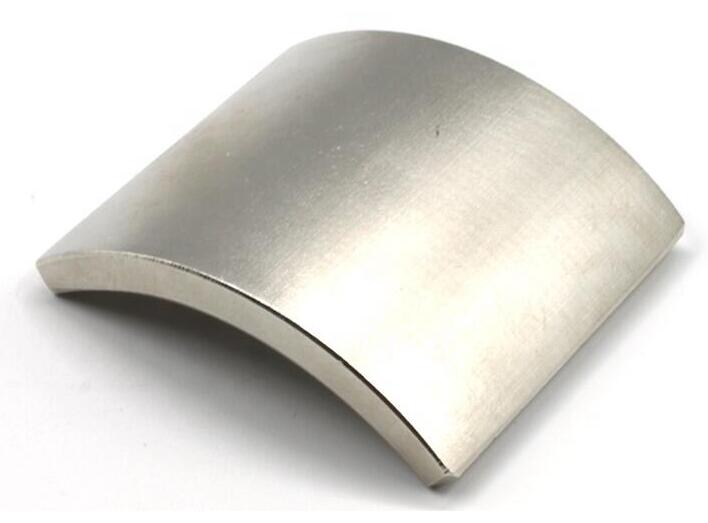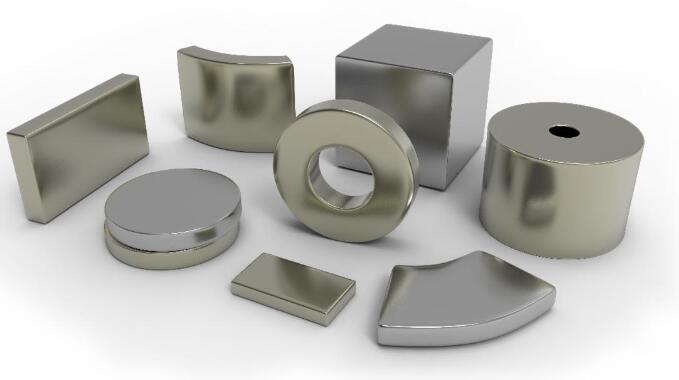Classification of Neodymium Magnets
According to the different production processes, Neodymium Magnets can be divided into three types: sintered NdFeB magnets, bonded NdFeB magnets, and hot-pressed NdFeB magnets. Due to different production processes, they have big differences in product magnetic properties, post-processing, and applications.
1. Sintered NdFeB Magnet
Sintered NdFeB magnet is the product with the largest output and the most widely used in the NdFeB family. It is produced by the powder metallurgy method and can be divided into 7 series of N, M, H, SH, UH, EH and TH according to the different coercivity of the product. The sintered NdFeB magnet that has been commercially produced has a remanence of up to 1.45T and an intrinsic coercive force of up to 2786kA/m. The operating temperature is between 80° and 200° depending on the coercivity. The Sintered NdFeB magnet is easily oxidized and corroded, so surface treatment is required. According to the different requirements of the use environment, phosphating, electroplating, electroless plating, electrophoresis, vapor deposition, and other surface treatment methods can be used. Common coatings are zinc, nickel, nickel-copper-nickel, epoxy resin, etc.
2. Bonded NdFeB Magnet
Sintered NdFeB magnets are difficult to process into special shapes, and they are easy to crack, break, and difficult to assemble during the process. In order to solve these problems, people tried to crush the permanent magnets and mix them with adhesives, and then press them into a shape in a magnetic field. Thus, the bonded NdFeB magnet was developed. It has the advantages of low cost, high dimensional accuracy, a large degree of freedom of shape, good mechanical strength, light specific gravity, etc., and has been widely used in the market. There are currently 4 processes for forming bonded neodymium magnets: calendering, injection molding, extrusion, and compression molding, of which calendering and injection are more mainstream. Bonded NdFeB magnets are generally only 80% of theoretical density due to the addition of a large amount of adhesive, so they are weaker than sintered NdFeB magnets in terms of magnetic properties. Bonded NdFeB magnets are isotropic magnets, with the same magnetism in all directions, so they are convenient to manufacture multi-pole monolithic magnets. (Bonded NdFeB magnets can also be made into anisotropic magnets)
3. Hot-Pressed NdFeB Magnet
Hot-pressed NdFeB magnets can achieve magnetic properties similar to sintered NdFeB without adding heavy rare earth elements. They have the advantages of high density, high orientation, good corrosion resistance, and high coercivity, but the mechanical properties are not good. And due to patent monopoly and high processing costs, only a few companies on the market have achieved mass production of hot-pressed NdFeB magnets. Due to the limitation of the molding technology, the current hot-pressed NdFeB can only be made into a ring shape, and the application range is limited to a certain extent. It is currently mainly used in the field of automobile EPS motors. The hot-pressed NdFeB magnets have high magnetic performance, and the maximum radial magnetic energy product of the magnetic ring can reach 240~360kJ/m3. The magnetic ring is oriented in the radial direction, and the radial magnetic performance is uniform, which can make the motor run quietly and the torque output is smooth. At the same time, it also has high heat resistance, and the working temperature can reach 180℃-200℃.












